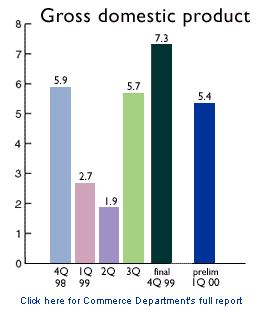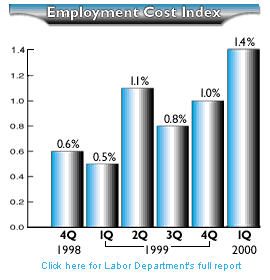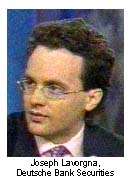|
GDP slows, labor costs up
|
 |
April 27, 2000: 8:48 a.m. ET
First-quarter employment costs jump 1.4%; prices surge; GDP growth eases
By Staff Writer M. Corey Goldman
|
NEW YORK (CNNfn) - The U.S. economy downshifted a bit in the first quarter, but employment costs for companies posted their strongest jump in more than 10 years and inflation surged, the government reported Thursday -- providing more evidence that the economy is running at a swift pace and likely will be doused by more interest rate increases by the Federal Reserve.
 Gross domestic product, the broadest measure of goods and services produced, advanced at a 5.4 percent pace in the first quarter, below both analysts' forecasts and the 7.3 percent pace registered in the fourth quarter. Robust consumer spending fueled much of the gains. Gross domestic product, the broadest measure of goods and services produced, advanced at a 5.4 percent pace in the first quarter, below both analysts' forecasts and the 7.3 percent pace registered in the fourth quarter. Robust consumer spending fueled much of the gains.
But the GDP price deflator, a key measure of inflation, jumped 2.7 percent in the quarter, well above the fourth quarter's 1.9 percent pace and analysts' predictions.
And the Labor Department reported that labor costs rose at a 1.4 percent annual rate in the first quarter, above the 1 percent gain registered in the fourth quarter and economists' predictions of a 0.9 percent increase. The increase was the strongest since the third quarter of 1989. The seasonally adjusted employment cost index measures companies' wage, benefit and salary costs over a three-month period.
Combined, the reports suggested what analysts and investors have been concerned about for some time -- that the robust U.S. job market is beginning to spur employers to pay higher salaries and benefits, and that consumers armed with heftier paychecks and backed by paper gains from the stock market are ready and willing to pay more for goods and services.
A sharp uppercut?
"The longer we go along this path, the clearer it becomes that the Fed may have to jolt consumers and investors with a more aggressive policy," said Oscar Gonzalez, an economist with John Hancock Financial Services Inc. in Boston. "Instead of jabs, the Fed may have to go with a sharp uppercut" -- doing that by increasing rates at a faster pace.
 Indeed, stocks plunged at the opening bell as investors concluded the Fed likely will lift its benchmark lending rate by at least a quarter point next month -- possibly even a half point, as some analysts have forecast, or by a quarter-point even before its May 16 meeting. That would be aimed at slowing the booming U.S. economy, now in its ninth year of record uninterrupted expansion. By the end of the day, the Dow remained mired in negative territory, while the tech-heavy Nasdaq managed to reverse course and post a broad gain. Indeed, stocks plunged at the opening bell as investors concluded the Fed likely will lift its benchmark lending rate by at least a quarter point next month -- possibly even a half point, as some analysts have forecast, or by a quarter-point even before its May 16 meeting. That would be aimed at slowing the booming U.S. economy, now in its ninth year of record uninterrupted expansion. By the end of the day, the Dow remained mired in negative territory, while the tech-heavy Nasdaq managed to reverse course and post a broad gain.
What all the numbers confirmed to analysts and some investors is that the U.S. economy is running too quickly for its own good. For more than four years, the economy has been advancing at a strong pace, but without any significant signs of inflation, mostly because companies had managed to keep their costs -- and the prices for their goods and services -- in line.
What had kept companies from raising prices so far have been strong gains in worker productivity, in which advances in technology -- everything from smaller and faster computer chips to wireless phones -- have kept wage costs down. But Thursday's report indicated that those costs, which account for more than two-thirds of a typical company's expenses, are starting to rise.
Spend, spend, spend
And that was just one side of the numbers. The GDP report also showed that prices for goods and services are indeed starting to rise, as consumers armed with fatter paychecks and additional paper gains from stock options and other benefits are all too willing to pay more for everything from food and shelter to vacations and new cars, analysts said.
 Joseph Lavorgna, chief economist with Deutsche Bank Securities, told CNNfn that, in the wake of Thursday's reports, it isn't as obvious to financial markets exactly how much further the Fed will have to go to slow the U.S. economy and reign in inflation pressure -- even if policy makers raise interest rates by a half point in May. (550KB WAV) (550KB AIFF) Joseph Lavorgna, chief economist with Deutsche Bank Securities, told CNNfn that, in the wake of Thursday's reports, it isn't as obvious to financial markets exactly how much further the Fed will have to go to slow the U.S. economy and reign in inflation pressure -- even if policy makers raise interest rates by a half point in May. (550KB WAV) (550KB AIFF)
One thing Lavorgna and most other Wall Street economists agree on is that the Fed's policy arm, the Federal Open Market Committee, will certainly raise rates again next month. The fed funds rate, the benchmark target rate the Fed sets for overnight lending between banks, currently is 6 percent. The Fed last raised the rate by a quarter point on March 21.
After Thursday's reports, the only question seems to be how much the Fed will move and, to some extent, when. Some economists now say that Fed officials will raise rates a half point in May, or even before their next meeting -- a move Wall Street hasn't seen since the mid-1990s.
A half-point hike?
Bruce Steinberg, chief economist with Merrill Lynch, upped his forecast to a half-point rate hike in May. A poll conducted by Reuters late Thursday found that roughly a third of Wall Street's primary dealers did the exact same thing.
Lavorgna said the only thing that will stop the Fed from lifting rates at all is if it sees some notable improvement on the inflation front - something that could make its presence in upcoming economic reports such as April's employment and consumer price reports, due before next month's meeting.
 "For the inflation numbers to stay good from here on out or to improve, we need more productivity, and that's a leap of faith we don't want to make and a leap of faith we think the Fed won't want to make either," he said. "For the inflation numbers to stay good from here on out or to improve, we need more productivity, and that's a leap of faith we don't want to make and a leap of faith we think the Fed won't want to make either," he said.
A surge in consumer spending and business investment in the first three months of the year accounted for most of the increase in GDP. If not for a decline in the amount businesses invest in inventories, the overall increase would have been even higher, Moran said. Real final sales, which exclude inventories, rose at a 6.9 percent pace, the fastest increase since a 7.5 percent jump in the second quarter of 1984.
Consumer spending gained at an 8.3 percent annual rate in the first quarter, Commerce said, above the 5.9 percent increase in the fourth quarter and the fastest since an 8.6 percent jump in the second quarter of 1983. Consumer spending accounts for roughly two-thirds of U.S. economic output.
Deja vu?
Adding to the bearish numbers was the rise in employment costs. Since a year ago, wages and salaries advanced at a 4.3 percent pace, the biggest jump since the fourth quarter of 1991. Most of the gains came in higher benefits costs, which rose at a 2 percent pace. Wages and salaries alone advanced 1.1 percent, the Labor Department reported.
Employment costs is a crucial indicator for economists and the Fed because higher salaries and benefits can prompt firms to raise the prices they charge for goods and services, spurring inflation.
To be sure, the U.S. economy has been at this point before. Last spring, a surprise jump in April's CPI sent stocks into a tizzy, leading analysts to conclude that the U.S. economy had finally triggered inflation pressure. At the end of July, the Labor Department reported that wage costs surged to an eight-year high, prompting a similar reaction.
And yet inflation remained remarkably subdued in the second half of 1999, with employment costs declining to more moderate levels -- even as the economy chugged along at a furious pace -- with U.S. stock markets rounding out the year at record highs.
Separately, the Labor Department said Thursday that the number of Americans signing up for unemployment benefits rose to 283,000 in the week to April 22, a rise from 257,000 in the previous week that could indicate a slight easing in labor market pressures. 
|
|
|
|
|
 |

|

